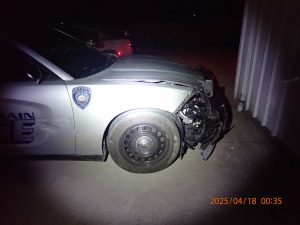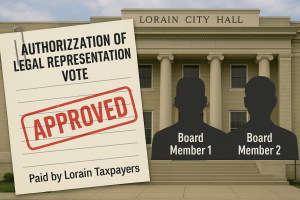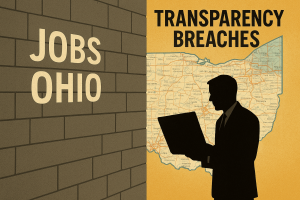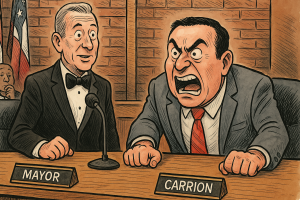Council Can’t Legislate Away the Second Amendment

Lorain’s War on the Bill of Rights
Aug 29, 2025
By Aaron C. Knapp — Social Worker, Republican, and Editor of Lorain Politics Unplugged
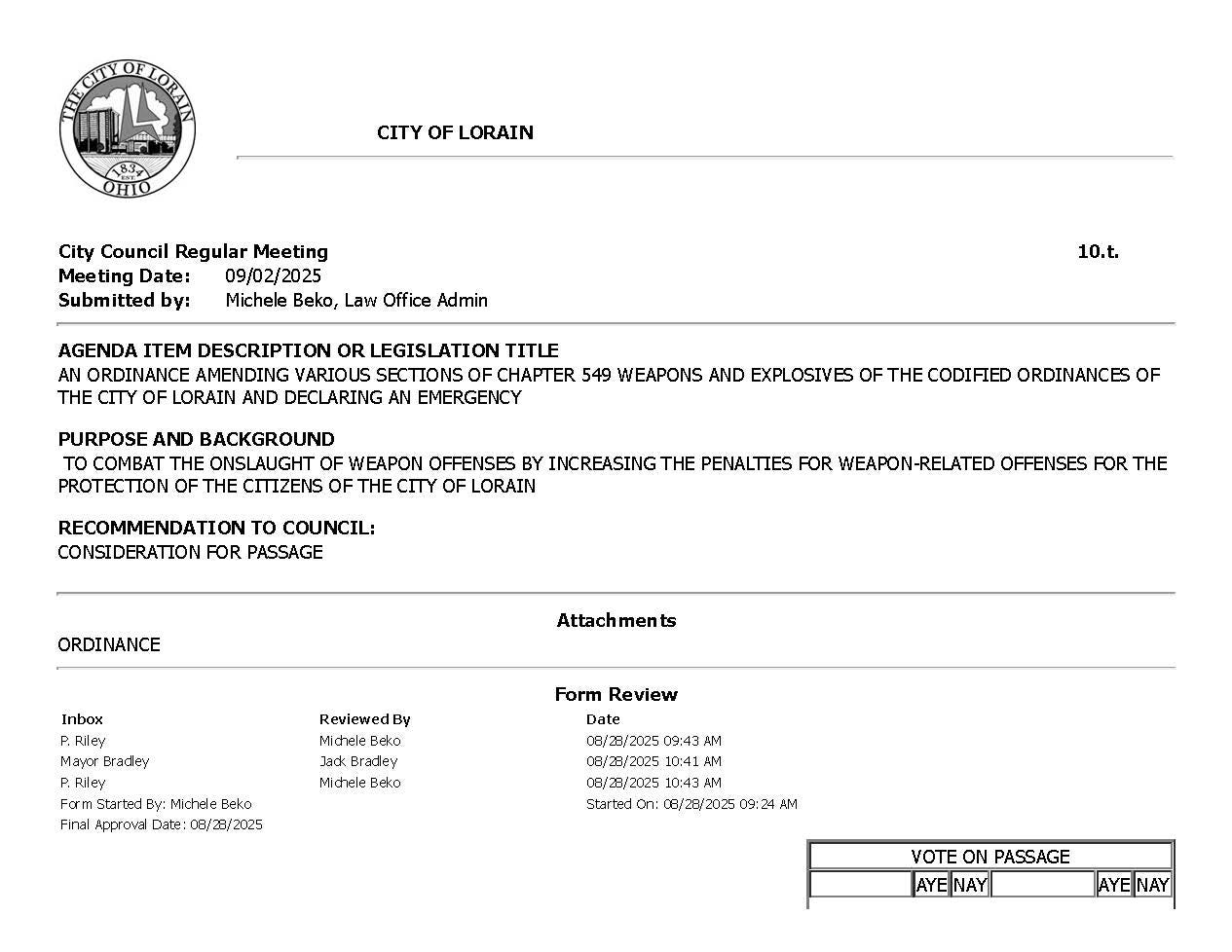
The September 2 Ordinance
On September 2, Lorain City Council will vote on an “emergency” ordinance amending Chapter 549 of the city’s code — its weapons and explosives section. The measure doesn’t just tweak language. It attempts a wholesale rewrite of the rules governing how Lorain residents may exercise rights already guaranteed to them under state and federal law.
Thanks for reading Aaron’s Substack! Subscribe for free to receive new posts and support my work.
At first glance, the ordinance looks like a response to concerns about public safety. But beneath the surface, it is something else entirely. It rewrites the city’s approach to carrying concealed weapons, handling firearms in vehicles, underage possession, and so-called “unlawful transactions.” By raising penalties and broadening definitions, the ordinance transforms minor missteps into major offenses. It does so without acknowledging that Ohio law already occupies this field — meaning Lorain is trying to regulate what it has no authority to regulate.
The penalty increases are not subtle. Offenses that were previously misdemeanors of the second or third degree — punishable by fines or short jail terms — are now elevated to misdemeanors of the first degree, the highest level before a felony. That means stiffer sentences, larger fines, and more permanent records. Technical violations that might once have been handled with a warning — paperwork mistakes, disclosure missteps during a traffic stop, misunderstandings about how to store a firearm in a vehicle — could now escalate into charges carrying the full weight of criminal law.
Worse still, the ordinance sweeps far beyond firearms. Even items that have long been considered outside the realm of “dangerous weapons” — knives, slingshots, air rifles — are being pulled into the city’s net. Tools that hunters use legally, that families store at home, or that young people might use for sport are suddenly treated as contraband. This is not about stopping armed criminals in the streets. It is about recasting ordinary citizens as offenders.
The justification? Council claims it is an “emergency.” But what exactly is the emergency? There is no spike in weapons offenses that state law doesn’t already cover. There is no new legal vacuum requiring immediate local action. The only emergency here is political: the need for city officials to appear tough on crime, regardless of whether the measures they adopt are lawful, enforceable, or constitutional.
This is fear-based lawmaking, not principled governance. And the consequences are predictable. Ordinary citizens will be caught in the dragnet. Taxpayers will foot the legal bills. And the ordinance, if passed, will almost certainly be struck down in court. In the meantime, Lorain will have sent its residents a dangerous message: that their rights can be rewritten by council vote whenever politics demands it.

Criminalizing the Ordinary
The net cast by this ordinance is far wider than firearms alone. Even items like knives, slingshots, and air rifles — tools that young people might use recreationally, hunters might transport legally, or families might store at home — are suddenly treated as part of Lorain’s weapons code.
“By redefining knives, slingshots, and air rifles as ‘weapons,’ Council is not targeting violent offenders. It is criminalizing ordinary conduct.”
Consider how absurd this becomes in practice. A Boy Scout troop transporting pellet guns to a weekend camp could be swept into the ordinance’s net. A father driving home with a hunting knife in the glovebox after a deer trip could be criminalized. A teenager walking down the street with a slingshot in his backpack — something that has happened for generations without issue — could suddenly face police intervention. Even a homeowner with an air rifle in the garage could be accused of violating the city’s code if the ordinance is interpreted broadly.
“A Boy Scout troop with pellet guns, a hunter with a knife, a teenager with a slingshot — under this ordinance, all of them could be treated as criminals.”
This is not how public safety is supposed to work. Public safety means punishing those who commit violence or pose real threats, not creating a sweeping dragnet that scoops up ordinary, everyday behavior. By doing this, Lorain is not strengthening the law; it is undermining it. Laws that are too broad are almost always selectively enforced — and selective enforcement means that those without money, power, or political connections will bear the brunt. That is not justice. That is profiling disguised as policy.
Ohio has already wrestled with this issue at the state level. The legislature defined what constitutes a “dangerous ordnance” and what does not. It balanced hunting rights, recreational use, and personal protection against public safety concerns. Lorain Council is not adding clarity to that balance; it is muddying the waters with a local ordinance that conflicts with settled state law. That creates confusion for police, prosecutors, and citizens alike. And when laws are unclear, rights are the first casualty.
“Criminals don’t care about ordinances. What this law does is punish the compliant while doing nothing to deter the defiant.”
The truth is that criminals do not care about ordinances. They do not ask whether a city council has passed a new prohibition before committing a crime. They already operate outside the law. What this ordinance does is ensnare the people who are trying to follow the law — hunters, sportsmen, parents, and kids — and treat them as criminals for conduct that Ohio has always recognized as lawful. It punishes the compliant while doing nothing to deter the defiant.
And make no mistake: once government claims the power to criminalize something as ordinary as a slingshot, there is no limiting principle.
“Once government claims the power to criminalize something as ordinary as a slingshot, there is no limiting principle.”
If knives, air rifles, and pellet guns can be swept into the category of “weapons offenses,” what stops council from extending the same logic to tools, sporting equipment, or anything else that can be misused? This is the slippery slope of fear-based legislation — and Lorain is stepping on it with both feet.

The Constitutional Problem
Ohio is not like every other state. In 2006, the legislature passed R.C. 9.68, a law designed to end the confusion created by dozens of municipalities each trying to write their own weapons codes. The General Assembly declared:
“The individual right to keep and bear arms, being a fundamental individual right that predates the United States Constitution, is a matter of statewide concern… No political subdivision shall infringe upon these rights.” — R.C. 9.68(A)
That single sentence shut the door on local governments that wanted to legislate around the Second Amendment. If the state regulates firearms, local governments cannot add new restrictions. Period.
Lorain is pretending otherwise. By rewriting its Chapter 549 weapons code, the city is venturing into territory the state already governs: concealed carry, handling firearms in vehicles, penalties for possession, and even the definition of what constitutes a “weapon.” These are not gaps in state law. They are already comprehensively covered in the Ohio Revised Code.
The Ohio Supreme Court has been clear on this point. In City of Clyde v. State (2008), the Court struck down Clyde’s ordinance banning guns in city parks, holding that R.C. 9.68 “is a general law that displaces municipal firearm ordinances.” Two years later, in Cleveland v. State (2010), the Court rejected Cleveland’s sweeping gun ordinances, reaffirming that home-rule powers do not permit cities to regulate what the state has already regulated.
“When state law covers the field, local law is void.” — Cleveland v. State (2010)
Those cases aren’t ancient history. They remain binding precedent today. Yet Lorain City Council is charging ahead with legislation that is virtually guaranteed to meet the same fate. Even recent challenges have failed. In Ohioans for Concealed Carry v. Oberlin (2014), the Ninth District Court of Appeals invalidated Oberlin’s attempt to ban guns in public parks. The message was consistent: municipalities cannot legislate around R.C. 9.68.
“R.C. 9.68 was enacted precisely to prevent the patchwork of conflicting firearm regulations that Lorain is now attempting to create.”
This means Lorain’s ordinance is walking straight into a legal buzzsaw. It doesn’t matter if the mayor signs it. It doesn’t matter if council declares it an “emergency.” The courts will strike it down. The city will spend years fighting a lawsuit it cannot win, all while claiming to defend public safety.
And here is the cruel irony: while the law is tied up in court, ordinary citizens will be subjected to arrests, fines, and possible jail time for conduct that the state of Ohio already permits. The city will be enforcing a law that is unenforceable — a charade that punishes people now for rules that will be void tomorrow.
“Lorain is gambling with rights it does not own. The Constitution belongs to the people, not to council.”
When the courts invalidate this ordinance — and they will — it won’t be the politicians who voted for it that bear the cost. It will be the taxpayers of Lorain, left holding the bill for legal fees, settlements, and wasted enforcement. Council knows this. Their law director knows this. Yet they are pressing forward anyway, because the spectacle of “tough on crime” politics is worth more to them than respecting the limits of the law.

A Guaranteed Legal Fight
If passed, this ordinance will not survive. That isn’t speculation. It is a legal certainty. Civil liberties groups and Second Amendment advocates have overturned nearly identical ordinances in city after city across Ohio and the country. Lorain will be no exception.
The moment this ordinance is enforced, it will draw a lawsuit. Organizations like Ohioans for Concealed Carry, the Buckeye Firearms Association, and even the NRA have historically stepped in when municipalities overstep their bounds. In Oberlin, for example, when the city council tried to keep its firearms ban on the books, Ohioans for Concealed Carry sued — and won. The court struck down Oberlin’s ordinance, and the city was forced to pay legal fees.
“When a law is preempted by R.C. 9.68, it is invalid and unenforceable.” — Ohioans for Concealed Carry v. City of Oberlin (2014)
That case is a warning shot to Lorain: lawsuits are not hypothetical. They are guaranteed. And when they come, it won’t be the mayor or the councilmembers who foot the bill. It will be every taxpayer in Lorain, forced to pay for years of litigation over an ordinance the courts will eventually erase.
The financial exposure is not small. In some cases, courts have ordered cities to pay attorney’s fees and damages to those prosecuted under illegal ordinances. Legal challenges like this can run into the hundreds of thousands of dollars. At a time when Lorain is already struggling to fund basic services — from roads to housing to public safety — council is preparing to spend scarce taxpayer money on a political stunt they know is doomed.
“The price tag of this political theater will be borne by everyone who pays taxes in this city.”
The danger is not limited to lawsuits. While the lawyers argue in court, ordinary people could face arrest, jail time, or crippling fines for conduct that state law already protects. Imagine being cited under Lorain’s ordinance, dragged into municipal court, and fined or jailed — only to have the ordinance later declared void. That is not justice. That is government overreach at its worst.
And make no mistake: council knows this. They cannot claim ignorance. The legal precedent is clear, binding, and public. They are not legislating in good faith; they are gambling with people’s rights and public money.
The strategy is as cynical as it is predictable: pass something flashy, call it an “emergency,” and claim credit for “cracking down” on weapons. Then, when the lawsuits roll in, blame the courts or “outside groups” for undermining public safety. It is political theater dressed up as governance.
This has played out before. In Cleveland, in Oberlin, in Clyde, and in Cincinnati, cities pushed local gun ordinances only to watch them collapse in court. Each time, taxpayers were left holding the bill, and residents were left wondering why their elected officials pursued policies that were unconstitutional from the start.
“Civil rights are not playthings. When cities try to legislate them away, courts do not hesitate to strike back.”
Lorain is not blazing a new trail here. It is repeating the mistakes of other municipalities that tried to legislate around the Constitution — and lost. The only question left is how much damage will be done before the courts inevitably strike this ordinance down.
Final Thought
This ordinance is not about safety. It is not about health. It is about politics. It is about appearances. By criminalizing what state law already permits, Lorain is telling its citizens that the city council, not the Constitution, decides their rights. That is not leadership. That is hubris.
As a Republican and as a social worker, I have seen firsthand what happens when governments try to legislate away rights under the guise of “public safety.” It never protects the vulnerable. It punishes them. This ordinance does not target gang violence or hardened criminals. It sweeps up ordinary citizens — hunters transporting rifles, teenagers with slingshots, homeowners with air rifles, or drivers who forget a technical disclosure during a traffic stop. These are not dangers to public order. They are part of the fabric of ordinary life in Ohio.
When government starts criminalizing everyday conduct, it is not protecting society. It is controlling it. That is not a slippery slope argument — it is the lived reality of municipalities that have already tried and failed to impose these kinds of laws. Every court that has reviewed such ordinances has said the same thing: you cannot legislate away a constitutional right just because it is politically convenient.
I support the Second Amendment 1000%. It is not negotiable. It is not optional. It is a fundamental right that predates the Constitution itself, recognized in both federal law and Ohio law. When Lorain City Council chooses to ignore that, they are not protecting the people — they are insulting them.
“The Constitution belongs to the people, not to council.”
That is why this fight matters. Because if a city can wake up one morning and decide that your rights don’t apply within its borders, then we no longer live under the rule of law. We live under the rule of men.
This ordinance is not just unconstitutional. It is un-American. It is an attack on the very principle of self-government — that rights are secured for all, not parceled out at the whim of politicians.
If Lorain’s leaders believe they can legislate away the Second Amendment, they will learn what other cities have already discovered: the Constitution has teeth, and the courts will bite back. Until then, the people of Lorain must ask why their council is so eager to gamble with their freedoms — and with their tax dollars — for the sake of political theater.
By Aaron C. Knapp — Social Worker, Republican, and Editor of Lorain Politics Unplugged
Disclaimer:
This article represents the views and analysis of the author in his role as a journalist, community advocate, and licensed social worker. It is written for informational, educational, and public-commentary purposes only. It does not constitute legal advice, does not create an attorney-client relationship, and should not be relied upon as a substitute for consultation with a licensed attorney. Laws and case precedents cited here are summarized for context and may not be exhaustive. Readers facing legal questions, charges, or disputes regarding firearms, municipal ordinances, or constitutional rights should seek qualified legal counsel in their jurisdiction.


